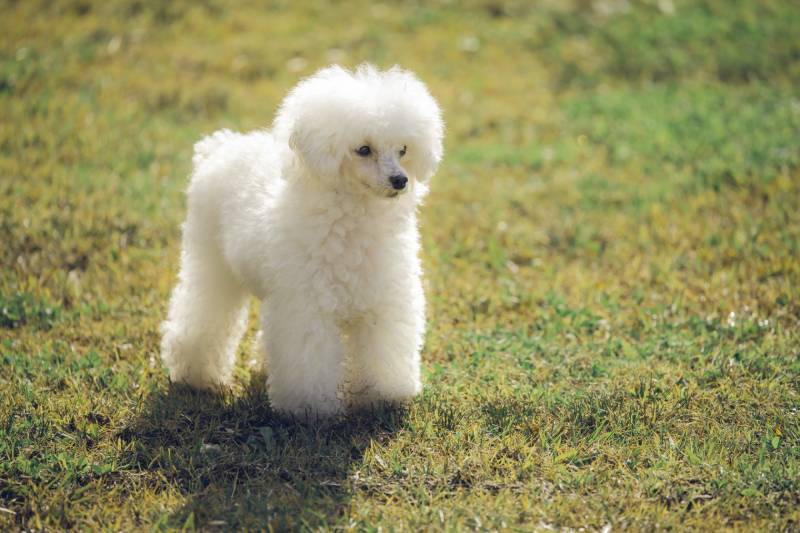In this article
View 3 More +The Maltipoo is a cross-breed of a Maltese and a Miniature or Toy Poodle. The Toy Poodle is a purebred dog, and the Maltipoo is considered a “designer breed.” The differences between the two range from training and exercise requirements to grooming needs. For instance, the Maltipoo and Toy Poodle are both highly trainable, but one requires a strong pack leader to avoid behavioral issues.
Let us look at these two breeds to determine what characteristics, personality traits, and other things you like or may find undesirable in a pet. Whether you are a senior looking for companionship, a parent who wants a pet for their children, or an individual looking for a show dog, this comparison will provide you with valuable information. Hopefully, you and your household will be enjoying your new pet soon!

Visual Differences

At a Glance
- Average height: 8–14 inches
- Average weight: 5–20 pounds
- Lifespan: 10–13 years
- Exercise: Minimum of 1 hour a day
- Grooming needs: Average
- Family-friendly: Yes
- Other Pet Friendly: Yes
- Trainability: Highly trainable, intelligent
- Average height: Up to 10 inches
- Average weight: 4–6 pounds
- Lifespan: 10–18 years
- Exercise: Low
- Grooming needs: Medium to high
- Family-friendly: Yes
- Other pet-friendly: Yes
- Trainability: Highly trainable, eager to please, intelligent

Maltipoo Overview
The Maltipoo is a hybrid that is the result of breeding a Miniature or Toy Poodle and a Maltese. The breed is playful and affectionate, which makes them the perfect pet for active households. Whether you are a first-time pet owner or have experience owning a dog, a Maltipoo is an ideal pet.
The breed makes an excellent companion for seniors and kids alike. The Poodle mix is an intelligent dog that is easy to train and loves spending time with their humans and other pets.
The Maltipoo is a small dog with a coat that is thick and can be curly or wavy. Although the coat is thick, the Maltipoo needs to be protected from extreme heat and cold. In the summer months, they require shade when they are playing in the yard. In the winter, they will enjoy a short 15-minute walk, preferably with a coat or sweater.

Personality / Character
A Maltipoo pup has a sweet, loving personality, and they love to cuddle and get showered with attention. They have a calm personality and a playful nature. Whether you are a senior looking for a calm and cuddly pet or have a home filled with children and activity, a Maltipoo will quickly settle into your home life. The breed loves attention and will keep their owner entertained with their playful antics and show of love and attention.
Since Maltipoos are a social breed, they are accepting of visitors and get along well with other pets too. They are known to bark when meeting a stranger or other dog, however.
Appearance
The Maltipoo is an adorable small breed with a soft and wavy coat. The face is round with a button-like nose and round, dark eyes. These facial features are why they continue to look like puppies even as adults.
The coat of a Maltipoo can come in a variety of colors, just like a Toy Poodle’s. The typical coat can be fawn, silver, white, brown, cream, and apricot. The colors are usually muted, however, due to the white genes of the Maltese. Although there are Maltipoos with red, brown, and black coats, these are rare colors for the breed.

Training
The Maltipoo is a highly intelligent dog that is easy to train. The breed is also eager to please and can make an excellent therapy or emotional-support dog, as well as an awesome pet.
Since they do tend to be vocal, it is important to teach them when they are pups to not bark. The positive reinforcement sessions should be a fun bonding experience between you and your Maltipoo. You can motivate them to learn and respond to commands by giving them treats and plenty of praise.
Health & Care
Since the Maltipoo is a small breed and not considered a purebred, they tend to have fewer health issues than Toy Poodles or large breed dogs. Common issues tend to be age related and include cataracts, arthritis, and dental problems. Like Toy Poodles, though, they are susceptible to a collapsed trachea. To help prevent damage to your pet’s throat, consider using a harness rather than a traditional collar.
Due to the social nature of this breed, they can experience anxiety if they are left alone or separated from their loved ones for a long time.
As with any pet, genetics and routine healthcare, among other things, can affect the health and lifespan of your Maltipoo. So, if you are not getting your pet from a rescue, be sure to purchase them from a reputable breeder.

Suitable For:
If you have a household with children and other pets, the Maltipoo will fit in fine. The dog has the energy to keep up with the daily activities in a busy household and has a personality that will go along with strangers and other dogs.
The calm and affectionate nature of the Maltipoo also makes them a good match for one-person households and seniors. They do not do well being left alone for prolonged periods, however.

Toy Poodle Overview
The Toy Poodle is a purebred toy breed that originated from the standard Poodle. They are intelligent, sweet, and good with children and other pets. They require a strong pack leader, however. Toy Poodles love people and respond well to training. They are a friendly breed that needs to be highly socialized. They love to be with people, but they can be protective of their owners. In addition to being socialized, they require exercise and stimulation to prevent them from becoming timid and strung out.
The Toy Poodle is an excellent breed for individuals who live in an apartment in the city or families who live in the country. They enjoy going on walks, cuddling on the couch, and frolicking in the yard.
Pet owners looking for a show dog will find the Toy Poodle to be an excellent choice. They are talented canines that are known for competing in agility and obedience, retrieving, performing watchdog tasks, and doing tricks.

Personality / Character
Toy Poodles are energetic and intelligent dogs that are easy to train. This sweet and happy breed likes to entertain and delight their audience. They get along well with other dogs and enjoy socializing with them.
If you own a Toy Poodle, you will need to lead the pack, however. They will develop small dog syndrome if it is not given the proper boundaries and expected to follow the rules. If allowed to lead the pack, they may engage in negative behaviors like snapping, demanding, growling, and guarding.
In addition, they can become iffy with children and strangers. Being left to be the boss can make them nervous, sensitive, and timid around strangers. Since these are not typical traits of the Toy Poodle, they do best with owners who are consistent and firm pack leaders.
Exercise
Toy Poodles with a confident pack leader who provides them with mental and physical exercise are trustworthy and mentally stable. While these dogs like to play and run around in the yard, they still need a daily walk to prevent behavioral issues.
Training
Toy Poodles are highly intelligent and responsive to training. They require an owner who is the leader of the pack. If they are not well trained, they should not be left alone with small children. They will do well, however, with older children who know how to be a pack leader. The breed is excellent in the show ring since they are talented, highly trainable, and intelligent. They can easily learn how to do tricks and competitive obedience, among other things.

Health & Care
Health problems that are common among Toy Poodles include diabetes, heart problems, epilepsy, slipped stifle, immune-mediated hemolytic anemia, progressive retinal atrophy (PRA), ear infections, runny eyes, and problems with their digestive tract.
PRA and cataracts can cause blindness in Toy Poodles, and they are susceptible to certain skin conditions that may be the result of improper use of clippers. It is also common for Toy Poodles to have allergies to the color reinforcers and shampoos used on their coats, and brown Poodles can gray prematurely.
Show Dogs
Owners who want to show their Toy Poodles should expect to spend time and money to have their dogs groomed. Show dogs require extensive grooming that includes regular bathing and teeth scaling. The ears will need frequent monitoring for ear mites, wax, and infections. The hairs in the ear canal will also need to be removed.
To keep the Toy Poodle’s coat in top condition, it should be groomed every 6 to 8 weeks. For the show ring, there are several types of clips allowed, including the “Puppy Clip,” the “Lamb Clip,” and the “English Saddle,” to name a few.

Suitable For:
Toy Poodles are well suited for families and individuals. However, if you have small children, you will need to be sure to be firm and consistent with your Toy Poodle so they know the rules and boundaries. For individuals looking for a dog to enter in the show ring, this dog is an excellent choice. The breed is highly trainable and multi-talented, so they do quite well.

Which Breed Is Right for You?

If you are looking for a small breed that is lovable and playful and will fit well into a home with small children, the Maltipoo is a good option. The breed is good with children, seniors, visitors, and other pets. The Maltipoo is energetic and will appreciate the activity of a busy home. They do not do well in home where they are frequently left alone, however.
For individuals who live in an apartment in the city, seniors who live alone, or those looking for a show dog, the better option may be the Toy Poodle. They are highly intelligent and trainable but need a consistent pack leader. As a show dog, the Toy Poodle is a talented pup that can compete in agility, retrieval, watchdog, tricks, and competitive obedience.
The toy breed is not necessarily a bad match for an active family with smaller children, however. They just need to be well-trained, know their boundaries, and consistently follow the rules. Otherwise, they can exhibit bad behaviors like nipping, demanding, and growling.
See Also:
Featured Image Credit: Top – Maltipoo (marketlan, Shutterstock), Bottom- Toy Poodle (NDAB-Creativity, Shutterstock)




















2 Responses
we just rescued a 7 year old maltipoo who weighs 14 pounds so perhaps he was mixed with a miniature poodle?
Hello John,
thank you for your message. It is admirable that you rescued a Maltipoo and gave them a chance for a new home. Maltipoos are usually a mix of Maltese and either Toy or Miniature Poodle, so it is possible that with the weight you mentioned, your Maltipoo can be of the later descent.
If you would ever need a veterinary consultation that wouldn't require an in-person visit at the clinic, we would recommend you booking an appointment with one of our veterinarians from www.PangoVet.com. During a 20-minute video-call you can ask all your questions and our vets will try to give you the best care advice, specifically for your dog.
We wish you many wonderful years together!